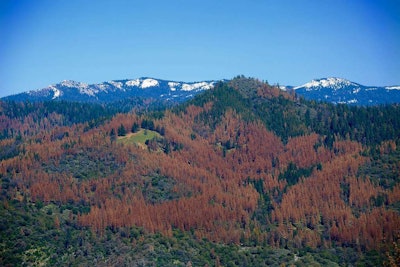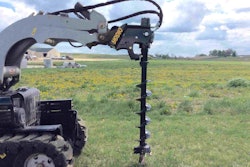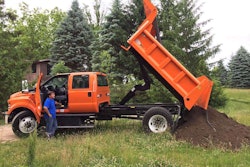 Dead trees cover the mountains in the Sierra National Forest.
Dead trees cover the mountains in the Sierra National Forest.Photo: U.S. Forest Service Region 5/Flickr
California is in its fifth year of drought, yet residents are receiving mixed signals as to whether water conservation should still be a priority.
A study published in Geophysical Research Letters has estimated that it will take about 4.4 years for the Sierra Nevada snowpack to recover. Out of the 65 years studied, the current drought has resulted in the highest cumulative deficit of water from the snowpack.
The snowpack provides a third of the state’s water supply. In April 2015, with the snowpack at only 5 percent of its average, Gov. Jerry Brown ordered a 25 percent reduction in water usage.
This year, even though El Nino was expected to be particularly strong, replenishment of the Sierra Nevada snowpack fell short of state officials’ high hopes. However, it did reach 87 percent of normal – a level many found encouraging.
Researchers say that during most drought events, the Sierra Nevada snowpack is able to recover within a year. That’s not the case this time – there is only a 7 percent chance that the deficit will recover in 2016 – due to the current drought’s severity.
“What we’ve seen in the last four years might be the new normal going forward,” Steve Margulis, the lead researcher and professor at UCLA’s Henry Samueli School of Engineering and Applied Science, told the Los Angeles Times. “Under climate change, if this kind of deficit happens more frequently, then longer-term recoveries will become more common.”
The snowpack isn’t the only natural element that has been suffering under the drought. The U.S. Forest Service has estimated that since 2010 around 66 million trees have died in California, particularly in the central and southern Sierra.
A combination of bark beetles, warmer temperatures and the drought have all played a part in creating the swaths of dead trees seen from aerial surveys. In October, Brown created a task force to remove the trees as quickly as possible before wildfire season.
So far the U.S. Forest Service has cut down 77,000 trees that pose a greater threat to people and has committed $32 million to California to help with the cause.
“Tree die-offs of this magnitude are unprecedented and increase the risk of catastrophic wildfires that put property and lives at risk,” said Tom Vilsack, U.S. secretary of agriculture, in a statement. “We must fund wildfire suppression like other natural disasters in the country.”
Despite these worrisome environmental reports, water districts are dropping their mandatory conservation regulations. Local water providers are allowed to do so as long as they prove to the State Water Resources Control Board that they can meet customer demands for three severely dry years.
Coachella Valley Water District will go from trying to cut its water usage by 36 percent to 0 percent. It says that its customers have saved about 9.5 billion gallons since June 2015 and it has 10 million more acre feet of water than the district needs to meet demands.
“We expect our customers will be able to voluntarily maintain these reduced levels of water use,” General Manager Jim Barrett told the Los Angeles Times. “If not, new mandates may be developed.”
Other water districts, like the Municipal Water District of Orange County, say they have met the state’s stress test but will ask residents to reduce water consumption by 10 percent. The state water board will review the districts’ proposed conservation plans and can reject them if something appears “materially false.”
Experts and other environmentalists have expressed concern about leaving water conservation up to the public.
“It’s certainly not the time to back off of conservation,” said Tracy Quinn, a water policy analyst for the Natural Resources Defense Council. “We did such a great job of getting people to change their behaviors … and now we’re saying, ‘Oh the drought’s over’ – and that’s simply not the case.”










